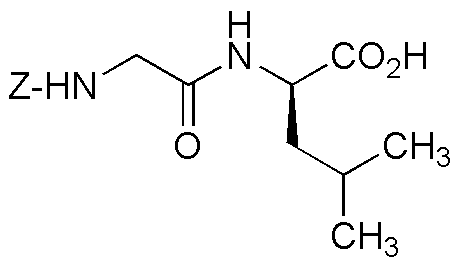Z-Gly-D-Leu-OH is widely utilized in research focused on:
- Peptide Synthesis: This compound serves as a building block in the synthesis of peptides, particularly in the development of bioactive peptides that can be used in pharmaceuticals and nutraceuticals.
- Drug Development: It plays a crucial role in the design of peptide-based drugs, offering potential therapeutic applications in treating various diseases, including cancer and metabolic disorders.
- Biochemical Research: Researchers use it to study protein interactions and enzyme activities, enhancing our understanding of biological processes and disease mechanisms.
- Cosmetic Formulations: The compound is incorporated into cosmetic products for its potential skin benefits, such as promoting collagen production and improving skin elasticity.
- Food Industry: It is explored as a flavor enhancer or functional ingredient in food products, contributing to taste and nutritional value.
General Information
Properties
Safety and Regulations
Applications
Z-Gly-D-Leu-OH is widely utilized in research focused on:
- Peptide Synthesis: This compound serves as a building block in the synthesis of peptides, particularly in the development of bioactive peptides that can be used in pharmaceuticals and nutraceuticals.
- Drug Development: It plays a crucial role in the design of peptide-based drugs, offering potential therapeutic applications in treating various diseases, including cancer and metabolic disorders.
- Biochemical Research: Researchers use it to study protein interactions and enzyme activities, enhancing our understanding of biological processes and disease mechanisms.
- Cosmetic Formulations: The compound is incorporated into cosmetic products for its potential skin benefits, such as promoting collagen production and improving skin elasticity.
- Food Industry: It is explored as a flavor enhancer or functional ingredient in food products, contributing to taste and nutritional value.
Documents
Safety Data Sheets (SDS)
The SDS provides comprehensive safety information on handling, storage, and disposal of the product.
Product Specification (PS)
The PS provides a comprehensive breakdown of the product’s properties, including chemical composition, physical state, purity, and storage requirements. It also details acceptable quality ranges and the product's intended applications.
Certificates of Analysis (COA)
Search for Certificates of Analysis (COA) by entering the products Lot Number. Lot and Batch Numbers can be found on a product’s label following the words ‘Lot’ or ‘Batch’.
*Catalog Number
*Lot Number
Certificates Of Origin (COO)
This COO confirms the country where the product was manufactured, and also details the materials and components used in it and whether it is derived from natural, synthetic, or other specific sources. This certificate may be required for customs, trade, and regulatory compliance.
*Catalog Number
*Lot Number
Safety Data Sheets (SDS)
The SDS provides comprehensive safety information on handling, storage, and disposal of the product.
DownloadProduct Specification (PS)
The PS provides a comprehensive breakdown of the product’s properties, including chemical composition, physical state, purity, and storage requirements. It also details acceptable quality ranges and the product's intended applications.
DownloadCertificates of Analysis (COA)
Search for Certificates of Analysis (COA) by entering the products Lot Number. Lot and Batch Numbers can be found on a product’s label following the words ‘Lot’ or ‘Batch’.
*Catalog Number
*Lot Number
Certificates Of Origin (COO)
This COO confirms the country where the product was manufactured, and also details the materials and components used in it and whether it is derived from natural, synthetic, or other specific sources. This certificate may be required for customs, trade, and regulatory compliance.


